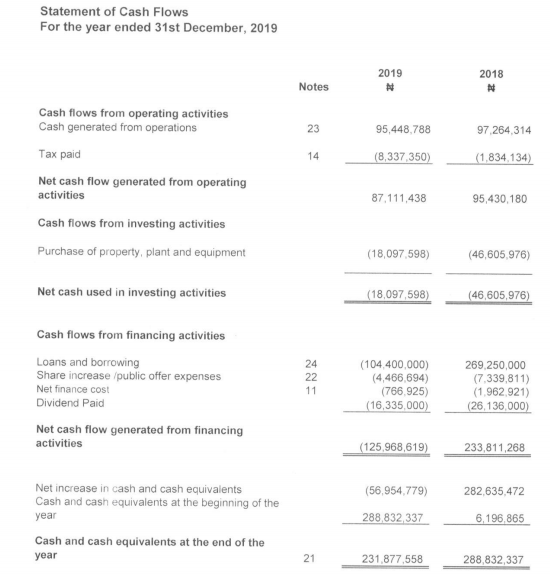In the preceding weeks, we have discussed the Statement of Financial Position (aka Balance Sheet) and the Income Statement (aka Statement of Profit/Loss). While the balance sheet lets us know the financial health of the business, the income statement lets us know if the business is making profit.
Do you recall our Friends at Obi and Ada Enterprises? Having started the business and financed it with a combination of their savings, investment from relatives and loan from banks, they used the balance sheet to understand what this money invested had become. With the income statement they could see how profitable or otherwise their business is.
What about the management of cash in the company, the essential ingredient that keeps any business, big or small moving; cash flow? Today, we will be discussing the Cash Flow Statement.
The statement of cash flow, or the cash flow statement, is a financial statement that summarizes the amount of cash and cash equivalents entering and leaving a company.
The cash flow statement (CFS) measures how well a company manages its cash; how well the company generates cash to pay its debt obligations and fund its operating expenses. The CFS complements the balance sheet and income statement.
- Read more;
- How much is the Business worth: The Stories Income Statement Tell
- Cutix Plc Board proposes 12.5kobo dividend, discloses date for filing of its audited reports
Everyone with basic knowledge about business, will appreciate and understand the importance of cash flow in a business. As an investor or business manager, the CFS throws light on the financial footing of the company.
The main components of the cash flow statement are:
- Cash from operating activities: This is the actual business activities of the company. In the case of Obi & Ada Enterprises, this will involve the procurement of farm produce from the villages, processing it at their facility in the city, and then selling it to the customers. The cash will leave the company as expenses, and come into the company as sales revenue.
- Cash from investing activities: These activities include any sources and uses of cash from a company’s investments. A purchase or sale of assets, loans made to vendors, or received from customers or any payments related to a merger or acquisition is included in this category. If you recall, Obi & Ada Enterprises had expanded their business by establishing a new store at another part of town; this constitutes investment activity.
- Cash from financing activities: The cash from financing activities include the sources of cash from investors or loan from banks, payment of dividends, payments for stock repurchases and repayment of loans are all included in this category. Changes in cash from financing are “cash in” when capital is raised, and they’re “cash out” such as when dividends are paid.
Let us examine a cash flow statement from a company listed on the Nigerian Stock Exchange, engaged in a Business similar to that engaged in by Obi and Ada Enterprises.

If you look at the CFS above, you will see the three types of activities; Cash flow from operating activities, Cash flow from investing activity, and Cash flow from financing activities.
- Read also; You must be Flexible in order to Succeed in Business
- 8 Ways to Save Money in Financial Difficulty
The company is generating a lot of cash from its operating activity, and has a positive cash flow from the operating activity, and also a positive cash flow overall. It can be inferred from the CFS that the company is on a solid financial footing.
Written by;
Nnamdi M.
























































